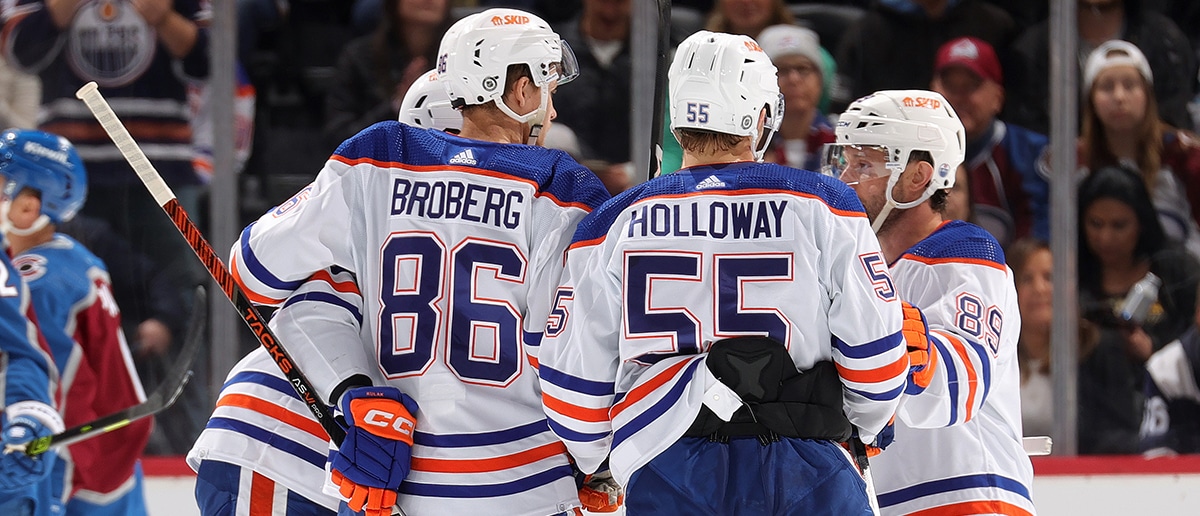
Hockey fans across the continent woke up to surprising news on Tuesday morning, as the St. Louis Blues announced that they had tendered two offer sheets to Philip Broberg and Dylan Holloway, both of the Edmonton Oilers. This now starts a seven-day clock where the Western Conference champions must decide whether or not they will match the deals or move on from the players in exchange for the allotted compensation. Let’s take a look at the recent history of offer sheets, how this impacts Edmonton from a salary cap perspective, and whether or not it makes sense to keep the players.
Offer Sheets A Rarely-Used Tool
For those out of the loop, offer sheets are a tool that gives restricted free agents some flexibility in their futures. Players early in their careers, by age or NHL experience, typically cannot head straight to unrestricted free agency as long as their team makes an effort to hold onto their rights, giving them significant leverage in massaging ideal contracts for them in their first several seasons. This is especially the case for depth players, who can’t threaten to simply not sign and not play and have the same impact as a young star doing the same.
Restricted free agency gives these players the opportunity to speak to other teams and potentially sign with them, but that usually requires a combination of burning a bridge between general managers and organizations, paying a player more than their projected value to make the decision tougher for the rights-holding team, and giving up compensatory draft picks, making the experience uncomfortable and risky overall.
As such, we haven’t seen very many offer sheets in the modern era. While they were more common during the late 1980s and throughout the 1990s, a massive offer from Carolina to Detroit for Sergei Fedorov in 1998 – which included a $28 million first season as a poison pill – was the last one the league saw in the pre-salary cap era. It hasn’t gotten much more common since. While there were eight offer sheets in the first seven salary-capped seasons, these are just the third and fourth of the past 11 years.
Prior to today’s offer sheets, the most recent pair involved the Montreal Canadiens and Carolina Hurricanes. Montreal offered Sebastian Aho a five-year deal in July of 2019 that the Hurricanes matched, and two years later, they responded by offering a one-year, $6.1 million deal to Jesperi Kotkaniemi, including a bonus of $20 – matching Aho’s jersey number – in the deal to note that revenge was baked into the move. Montreal chose not to match, and Carolina paid a first and third round pick to close the acquisition.
For the Oilers, the most famous offer sheets likely are the pair that they doled out in the summer of 2007. First, they tried to sign Sabres sniper Thomas Vanek to a seven-year, $50 million deal – one that would’ve also sent four first-round picks the other way had Buffalo chosen not to match. The Sabres did match, not wanting to lose a young star after already losing Chris Drury and Daniel Briere to free agency. However, you can argue that they saved Edmonton from themselves, as those next four picks would be 12th (Tyler Myers), 10th (Magnus Paajarvi), first (Taylor Hall) and first (Ryan Nugent-Hopkins) overall in their drafts. Following that, they offered a five-year deal to Dustin Penner, which Ducks GM Brian Burke was so angry about that he challenged Oilers GM Kevin Lowe to a “barn fight” before ultimately taking the first, second, and third round picks.
Offers Put Oilers In A Bind
Back to the offers at hand. The Oilers are in a very tough spot right now when it comes to their salary cap situation. Presently, they already sit about $350,000 over the cap ceiling, according to our friends at Puckpedia.
Broberg’s offer sheet, a two-year deal, would have a cap hit of $4.581 million, while Holloway’s offer, also a two-year deal, would have a cap hit of $2.29 million. Were they to match both, the Oilers would be approximately $7.2 million over the salary cap.
Interestingly, it wouldn’t be impossible for them to navigate most of that salary in the immediate, though it would make things extremely tight. Evander Kane is expected not to be able to start the season with his hernia injury, and he might require surgery that hasn’t been undergone yet. This could buy them some time where they can tag his $5.125 million salary on long-term injured reserve. The $88.35 million total cap hit also factors for seven defencemen, and matching Broberg would bring them to eight. They could send down Josh Brown and Troy Stetcher to the minors (or lose them to waivers) to free up another $1.788 million. This still brings them a few hundred thousand short, though, and runs an extremely thin 20-man roster.
That’s to say nothing of the year after, where Leon Draisaitl and Evan Bouchard are both due massive raises that will likely exceed the growth of the cap ceiling. To make matters worse, much of the team’s money is tied in core players they wouldn’t want to move (the aforementioned pair, Connor McDavid, Zach Hyman, Ryan Nugent-Hopkins, Mattias Ekholm), or players that they just signed to deals in the last few weeks (Viktor Arvidsson, Jeff Skinner, Adam Henrique). Short of magically finding a suitor for Darnell Nurse and his $9.25 million cap hit or Cody Ceci and his $3.25 million tag in the next week, there isn’t a quick path out of the woods.
Edmonton Oilers to win 2025 Stanley Cup
What To Do On Decision Day
This finally brings us to the players themselves and what to do with them. Once again, assuming that they won’t be able to find a Hail-Mary cap move to clear Nurse and/or Ceci while taking little to nothing back in the next seven days, there isn’t a particularly sensible pathway to the Oilers successfully matching both offers. From a strictly technical standpoint, they could do so without going 10% over the cap ceiling, a move which is allowed during the offseason, but without a practical way to dig out of it, it wouldn’t seem wise.
Realistically, they’ll likely have to choose to either walk away from both players or keep one and use LTIR with Kane to buy them time to sort out a greater plan.
Of the two, I’d likely be inclined to keep Holloway. Edmonton has fewer committed forwards in their depth chart for this year, he’s a year younger, the cap hit of the offers is significantly lower, and the compensation for walking away is lesser. Holloway produced nine points in 38 regular season games, followed by seven points in 25 games during the playoffs, mixing in a degree of depth scoring with a healthy amount of physicality. He also produced at just under a point-per-game clip with Bakersfield in the American Hockey League.
While Broberg is a piece I have no doubt that they’d like to keep, as he’s a fairly young six-foot-three defenceman with an element of puck skill, I’d be inclined to walk away at the terms offered. A cap hit of $4.581 million over the next two years – that will have to be qualified afterwards to maintain the player’s rights – is a lot for someone with just 82 NHL games under his belt and under 13 minutes per game of average ice time. While his usage improved in the playoffs, that seemed largely a product of necessity, and rarely did it see him playing against top matchups – and even more rarely did it see him have success against them. St. Louis is making a bet on him having more to give, with less consequence if they’re wrong, as they shift towards a soft rebuild, but on a team where every dollar matters, it’s tougher for Edmonton to take the same risk.
Walking away from Broberg would give the Oilers a second-round pick – one that St. Louis reacquired from Pittsburgh this morning in what previously looked like a head-scratcher of a trade – as compensation. It’s not exactly what they would’ve wanted for the player a few months ago, but it’s reasonable when combining the player with reset contract expectations. They could then use that pick to either immediately acquire a different player moving along a similar role arc (Dylan Samberg of Winnipeg is one that comes to mind, should they be willing to move), or to make a more significant rental at the trade deadline.
Ultimately, what they decide to do won’t have a significant impact on their chances of going deep in the playoffs again – their core will drive that and remains the reason why they currently have the shortest Stanley Cup (+800), Presidents’ Trophy (+600), and Pacific Division (+160) odds – but this move by St. Louis does disrupt their offseason plans. It’ll be interesting to see which direction they ultimately head in the coming days.
